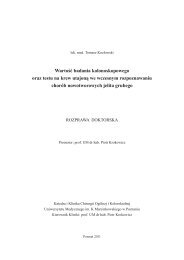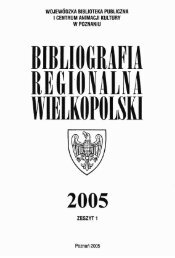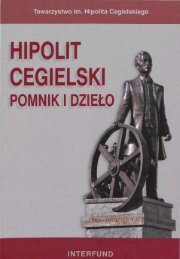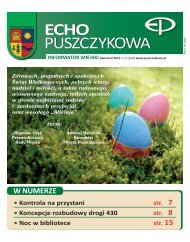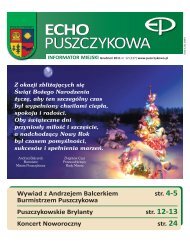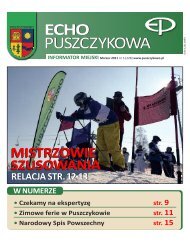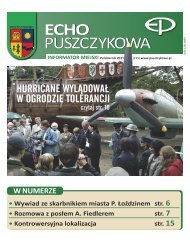© Military Pharmacy and Medicine • 2012 • 4 • 94 – 96Question 12. In the twelfth question we askedrespondents about the meaning of the term „saturation.”Only 30% of them were able to identifysaturation as blood oxygen concentration. Asmuch as 70% of subjects gave wrong answers.A detailed distribution of answers given byrespondents is depicted in Figure 4.Figure 5: .Answers provided by respondents to question 12.Question 13. This question also referred to assessmentof saturation level. Among the providedanswers („carbon monoxide poisoning,” “cyanidepoisoning,” „hyperthermia”) respondents wereto choose the state, in which saturation measurementwould be unreliable. Only 25% gave a correctanswer, while 75 people responded incorrectly.DiscussionOxygen, an element necessary for human existence,is also used as a drug [4, 5, 6]. Just like inany other case of drug administration, supplementationof oxygen should be given accordingto indications and with careful dosing. For thatpurpose firefighter rescue teams, who are oftenthe ones to administer first aid to victims beforearrival of medical emergency services, undergofirst aid training. First aid course, which lasts66 hours (involving 25 hours of theory and 41hours of practical training), includes issuesrelated to supplementation of oxygen therapy tocasualties [3].Unfortunately, there are no reports in the literatureon the problem of knowledge regardingprinciples of oxygen therapy amongfirefighter rescue teams. Therefore, it is not possibleto compare our results to those obtained byother authors.The level of self-confidence among firefightersfrom the studied group was high and amountedOriginal articleto 4.32 points. There was a great disparitybetween their self-evaluated knowledge and testresults, as evidenced by a 61% rate of incorrectanswers given by respondents. At this point, itis safe to say that members of firefighter rescueteams overstate their knowledge of oxygen therapyadministration.At the scene of rescue operation firefighterrescue teams may administer oxygen therapyto the patient according to first aid procedures.Oxygen therapy may be divided intopassive and active types [7]. In passive therapyoxygen is inhaled due to patient’s preservedventilatory function, while in case of activeoxygen therapy forced ventilation (replacementbreathing) is used [7, 8]. In our material,only 46% of respondents knew the differencebetween methods of passive and active oxygentherapy, as demonstrated by indicating patientventilation via nasal cannulas as an element ofpassive oxygen therapy.Symptoms of hypoxia include: skin cyanosis (ifdeoxygenated hemoglobin concentration fallsbelow 5 g/l) [4, 8]. Moreover, we may observeexcessive respiratory muscle work, which is asign of dyspnea. In case of central nervous systemhypoxia patient may be restless or aggravated.Severe hypoxia may be associated withloss of consciousness. The simplest, non-invasivemethod of evaluating the level of blood oxygensaturation at the site of rescue operation is pulseoximetry. Only 30% of respondents in our studygroup possessed the knowledge that saturation isa measure of oxygen content in arterial blood.Despite pulse oximetry being a routinely usedmethod of saturation measurement, in some situationsthis measurement may be unreliable (erroneous).An example of such situation is carbonmonoxide poisoning. As carbon monoxide hasalmost 250-fold greater affinity to hemoglobinthan oxygen, bonds created as a result of couplingof hemoglobin with carbon monoxide and carboxyhemoglobinformation are extremely strong.It leads to tissue hypoxia. In the above situation,pulse oximeter may show normal values despitethe true level of arterial blood oxygenation beingsignificantly lower. Carbon monoxide poisoningis dangerous, as the most susceptible organs suchas the cardiovascular system and central nervoussystem are damaged first. In severe carbon94 http://military.isl-journals.com
© Military Pharmacy and Medicine • 2012 • 4 • 95 – 96monoxide poisoning therapy in a hyperbaricchamber is the treatment of choice [9]. Fromour study group, 25% of subjects were familiarwith situations, in which pulse oximetry couldbe unreliable. Due to the possibility of airwayobstruction, manual methods of establishing airwaypatency applied first and followed by instrumentalmethods, firefighter rescue teams shouldpossess the knowledge of oropharyngeal tubeinsertion. Guedel tube is supposed to preventtongue slipping toward the posterior pharyngealwall and causing airway obstruction. A tube thatis either too large or too small may cause obstruction;hence it is important to know how to choosea proper one. Size of the tube should be fittedto each particular patient by placing the tubeagainst patient’s cheek. Tube collar (at the inlet)should be located near the incisors, while its endshould reach mandibular angle. A tube fitted insuch manner ensures airway patency, but dos notŁukasz Szarpak: Scope of knowledge regarding administration of oxygen therapy …prevent from regurgitation – passive movementof stomach contents into the esophagus withouta gag reflex – or from vomiting. Fifty-two percentof respondents knew how to appropriately fitan oropharyngeal tube. A rescue worker shouldremember that oropharyngeal tube should onlybe used in deeply unconscious victims. Most ofthe surveyed firefighters were familiar with thisprinciple, as much as 59% answered correctly.ConclusionsDue to the character of firefighter rescue teams’work, it is justified to examine the knowledgeregarding administration of oxygen therapyamong firefighters, as it may influence patientsurvival.Knowledge of oxygen therapy among firefightersis inadequate.References:1. Szarpak, Ł. ”Zintegrowany system ratownictwaelementem bezpieczeństwa państwa”, [w:] „Katastrofynaturalne i cywilizacyjne. Dylematy współczesnegobezpieczeństwa”, Wyższa Szkoła Oficerska WojskLądowych im. gen. T. Kościuszki, Wrocław 2011,s.127-138.2. Ziemba R. “Criteria of procedures in life-threateningstates”. Military pharmacy and medicine 2012, 5(2):62-68.3. Rozporządzenie Ministra Spraw Wewnętrznych orazMinistra Obrony Narodowej z dnia 23 grudnia 2011r. zmieniające rozporządzenie w sprawie szkoleń wzakresie kwalifikowanej pierwszej pomocy (Dz.U.2011 nr 299 poz. 1778).4. Powrie, K. and S. M. Smith. “Editorial: Emergencyoxygen for adults guideline--a change in oxygentherapy practice?” J.Clin.Nurs. 19.5-6 (2010): 601-02.5. O’Driscoll, R. “A breath of fresh air: a new UKguideline for emergency oxygen therapy.” Br.J.Hosp.Med.(Lond) 69.12 (2008): 670-71.6. Ziemba R (ed): ABC Ratownika – pierwsza pomoc wnagłych, IndexCopernicus, 2011, pp. 55.7. Austin, M. and R. Wood-Baker. “Oxygen therapy inthe pre-hospital setting for acute exacerbations ofchronic obstructive pulmonary disease.” Cochrane.Database.Syst.Rev.3 (2006): CD005534.8. Small, G. and P. Barsby. “How much is enough?Emergency oxygen therapy with COPD.” Emerg.Nurse8.8 (2000): 20-24.9. Van, Meter K. “Hyperbaric Oxygen Therapy as anAdjunct to Pre-hospital Advanced Trauma LifeSupport.” Surg.Technol.Int. XXI (2011): 61-73.http://military.isl-journals.com95



